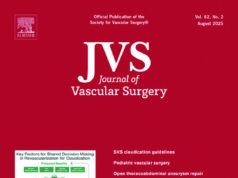 A recent systematic review showed that randomized trials comparing different types of peripheral endovascular arterial intervention have a high level of heterogeneity in their antithrombotic regimens. It also revealed an increasing trend for use of dual antiplatelet therapy post intervention with no clear justification.
A recent systematic review showed that randomized trials comparing different types of peripheral endovascular arterial intervention have a high level of heterogeneity in their antithrombotic regimens. It also revealed an increasing trend for use of dual antiplatelet therapy post intervention with no clear justification.
Authors Mahim I. Qureshi, MBBS, of North Bristol NHS Trust and University of Bristol in the U.K., and colleagues comment that this finding demonstrates a lack of standardization and poor reporting of antithrombotic therapy in randomized controlled trials of endovascular intervention.
Writing in the July issue of the European Journal of Vascular and Endovascular Surgery (EJVES), they remark that antiplatelet therapy needs to be standardized in trials comparing endovascular technologies in order to reduce potential confounding.
Exploring this potential for confounding, they remark that dual antiplatelet therapy increases the major bleeding risk, which may contribute to late mortality if regimens were continued long term. “This is especially relevant in the current climate,” they comment, highlighting that the trials included in this systematic review contributed to the late mortality results attributed to paclitaxel.
Qureshi and colleagues say that while randomized trials of new devices for peripheral arterial endovascular intervention are published regularly, the evidence for which antiplatelet and/or anticoagulant (antithrombotic) therapy to use after an intervention is lacking.
The aim of this systematic review, therefore, was to examine the antithrombotic regimens in randomized trials for peripheral arterial endovascular intervention to understand choices made and trends with time or type of device.
Qureshi et al sourced information from the Medline, Embase and Cochrane Library databases. They included randomized trials involving participants with peripheral arterial disease (PAD) undergoing any endovascular arterial intervention.
The investigators assessed trial methods to determine whether an antithrombotic protocol had been specified, its completeness, and the agent(s) prescribed. They classed antithrombotic therapy protocols as periprocedural, immediate post-procedural (up to 30 days following intervention), and maintenance post-procedural (therapy continuing beyond 30 days).
Qureshi and colleagues included 94 trials in the narrative synthesis. They note that study quality was low and that none of the trials justified their therapy protocol. Only 29% had complete periprocedural antithrombotic protocols, and 34% had complete post-procedural protocols.
The authors report in EJVES that antiplatelet monotherapy and unfractionated heparin were the most common regimen choices in the periprocedural setting, and dual antiplatelet therapy (55%) was most commonly utilized post procedure.
They write that over time there has been an increasing tendency to use dual therapy (p<0.001), which corresponds with the introduction of newer technologies and trials focused on below-the-knee interventions.
Qureshi et al’s results show that periprocedurally, aspirin remains the most widely adopted antiplatelet monotherapy, despite randomized evidence favoring clopidogrel. They note that reasons for this were unclear, but speculate that cost may be a factor as clopidogrel has only relatively recently come off patent. “There is the potential to reduce cardiovascular events periprocedurally by using clopidogrel in future trials,” they add.
In the discussion of their findings, the authors comment on potential bias in the randomized trials included in their study. They note that even though a formal meta-analysis could not be not performed, a risk of bias assessment was included as a marker of study quality. This showed a concerning amount of “unclear” bias such as detection bias and attrition bias, which can be compensated for by good trial design and follow-up.
Qureshi et al acknowledge that that their review has some limitations. They detail, for example, that it was impossible to tell whether some trials used antiplatelet agents alone in the periprocedural phase or whether they simply made no statement on heparin/anticoagulant use. They remark: “Because of this lack of clarity, it was impossible to confidently separate antiplatelet and anticoagulant use in these trials, which means some of the periprocedural regimens may not reflect ‘real-life’ practice during procedures.”
They emphasize also the strengths of their review, specifically its “all-encompassing search protocol” and “robust reporting of results,” but stress the need for an independent randomized trial specifically examining antiplatelet therapy following peripheral arterial endovascular intervention.
SOURCE: doi.org/10.1016/j.ejvs.2020.03.010












